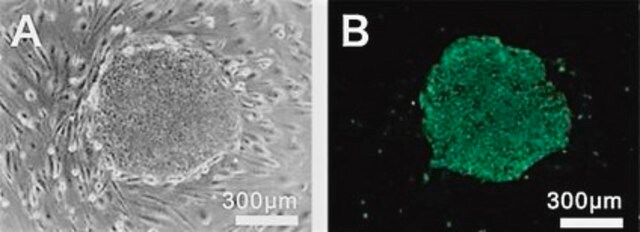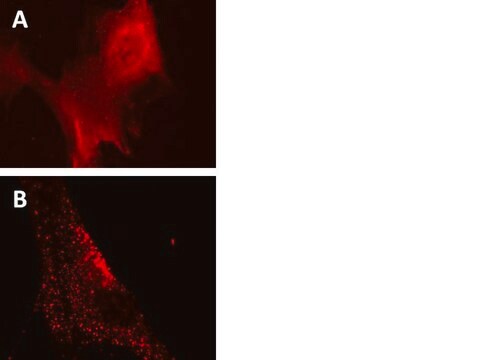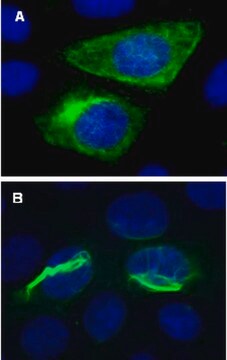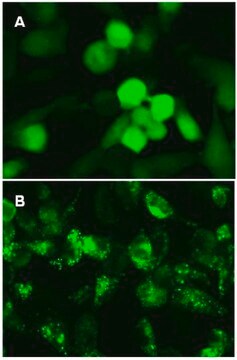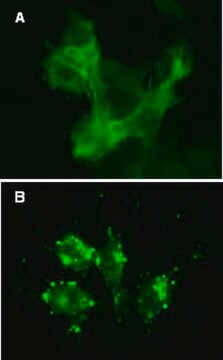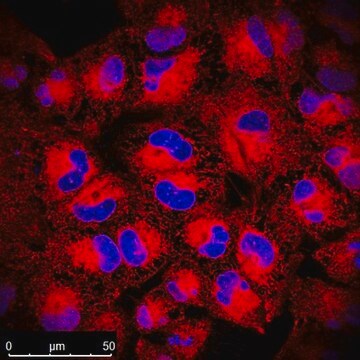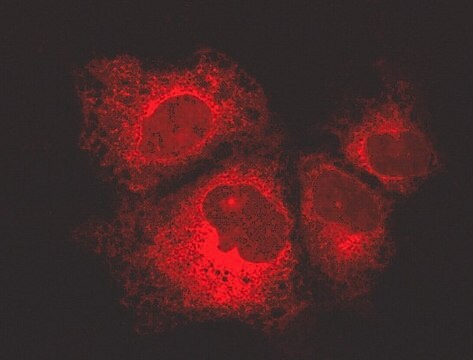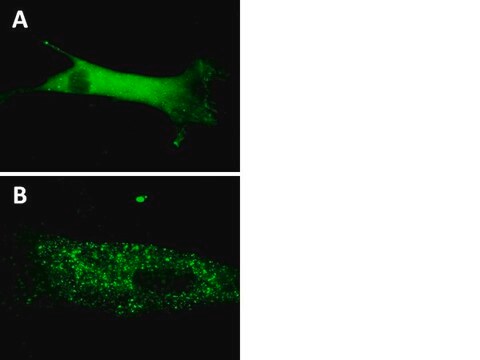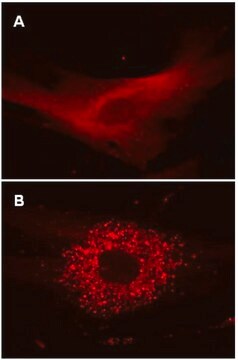17-10153
Biosensor lentiwirusowy LentiBrite RFP-Vimentin
Zaloguj sięWyświetlanie cen organizacyjnych i kontraktowych
About This Item
Kod UNSPSC:
12352207
eCl@ss:
34360190
NACRES:
NA.51
Polecane produkty
producent / nazwa handlowa
Chemicon®
LentiBrite
Poziom jakości
metody
cell based assay: suitable
immunocytochemistry: suitable
immunofluorescence: suitable
single cell analysis: suitable
transfection: suitable
numer dostępu UniProt
metoda wykrywania
fluorometric
Warunki transportu
dry ice
informacje o genach
human ... VIM(7431)
Opis ogólny
Przeczytaj naszą notę aplikacyjną w Nature Methods!
http://www.nature.com/app_notes/nmeth/2012/121007/pdf/an8620.pdf
(Kliknij tutaj!</A>)
Dowiedz się więcej o zaletach naszych LentiBrite Lentiviral Biosensors! Kliknij tutaj
Biosensory mogą być używane do wykrywania obecności/braku określonego białka, jak również subkomórkowej lokalizacji tego białka w żywej komórce. Znaczniki fluorescencyjne są często pożądane jako środek do wizualizacji interesującego białka w komórce za pomocą mikroskopii fluorescencyjnej lub poklatkowego przechwytywania wideo. Wizualizacja żywych komórek bez zakłóceń pozwala badaczom obserwować warunki komórkowe w czasie rzeczywistym.
Systemy wektorów lentiwirusowych są popularnym narzędziem badawczym wykorzystywanym do wprowadzania produktów genowych do komórek. Transfekcja lentiwirusowa ma przewagę nad metodami niewirusowymi, takimi jak transfekcja chemiczna, w tym wyższą wydajność transfekcji komórek dzielących się i nie dzielących się, długotrwałą stabilną ekspresję transgenu i niską immunogenność.
EMD Millipore wprowadza LentiBrite Lentiviral Biosensors, nowy zestaw wstępnie zapakowanych cząstek lentiwirusowych kodujących ważne i podstawowe białka autofagii, apoptozy i struktury komórkowej do wizualizacji w różnych stanach komórkowych/chorobowych w analizie żywych komórek i in vitro.
Cząsteczki lentiwirusowe LentiBrite RFP-Vimentin firmy EMD Millipore zapewniają jasną fluorescencję i precyzyjną lokalizację, umożliwiając analizę dynamiki IF wimentyny w komórkach trudnych do transfekcji.
http://www.nature.com/app_notes/nmeth/2012/121007/pdf/an8620.pdf
(Kliknij tutaj!</A>)
Dowiedz się więcej o zaletach naszych LentiBrite Lentiviral Biosensors! Kliknij tutaj
Biosensory mogą być używane do wykrywania obecności/braku określonego białka, jak również subkomórkowej lokalizacji tego białka w żywej komórce. Znaczniki fluorescencyjne są często pożądane jako środek do wizualizacji interesującego białka w komórce za pomocą mikroskopii fluorescencyjnej lub poklatkowego przechwytywania wideo. Wizualizacja żywych komórek bez zakłóceń pozwala badaczom obserwować warunki komórkowe w czasie rzeczywistym.
Systemy wektorów lentiwirusowych są popularnym narzędziem badawczym wykorzystywanym do wprowadzania produktów genowych do komórek. Transfekcja lentiwirusowa ma przewagę nad metodami niewirusowymi, takimi jak transfekcja chemiczna, w tym wyższą wydajność transfekcji komórek dzielących się i nie dzielących się, długotrwałą stabilną ekspresję transgenu i niską immunogenność.
EMD Millipore wprowadza LentiBrite Lentiviral Biosensors, nowy zestaw wstępnie zapakowanych cząstek lentiwirusowych kodujących ważne i podstawowe białka autofagii, apoptozy i struktury komórkowej do wizualizacji w różnych stanach komórkowych/chorobowych w analizie żywych komórek i in vitro.
- Wstępnie zapakowane, znakowane fluorescencyjnie za pomocą GFP i RFP
- Wyższa skuteczność transfekcji w porównaniu z tradycyjnymi metodami chemicznymi i innymi metodami transfekcji niewirusowej
- Zdolność do transfekcji dzielących się, nie dzielących się i trudnych do transfekcji typów komórek, takich jak komórki pierwotne lub macierzyste
- Brak zakłóceń funkcji komórkowych
Cząsteczki lentiwirusowe LentiBrite RFP-Vimentin firmy EMD Millipore zapewniają jasną fluorescencję i precyzyjną lokalizację, umożliwiając analizę dynamiki IF wimentyny w komórkach trudnych do transfekcji.
Filamenty pośrednie (IF) to struktury cytoszkieletowe o średnicy 10 nm, które zazwyczaj tworzą strukturę przypominającą klatkę, rozciągającą się od jądra do błony plazmatycznej. Pięć rodzin białek IF ma różne charakterystyki polimerowe i wzorce ekspresji specyficzne dla typu komórki. Ekspresja wimentyny, białka IF typu III, jest ograniczona do komórek mezenchymalnych, a pojawienie się wimentyny w nabłonkowych komórkach nowotworowych jest cechą charakterystyczną przejścia nabłonkowego do mezenchymalnego. Wimentyna łączy się w klasyczne długie filamenty i krótkie filamenty zwane squiggles. Mikroskopia poklatkowa żywych komórek z ekspresją RFP-wimentyny ujawniła dynamikę dojrzewania IF wimentyny oraz krzyżowanie się z mikrotubulami i mikrofilamentami.
Cząsteczki lentiwirusowe LentiBrite Vimentin-RFP firmy EMD Millipore zapewniają jasną fluorescencję i precyzyjną lokalizację, umożliwiając analizę dynamiki IF wimentyny w komórkach trudnych do transfekcji.
Cząsteczki lentiwirusowe LentiBrite Vimentin-RFP firmy EMD Millipore zapewniają jasną fluorescencję i precyzyjną lokalizację, umożliwiając analizę dynamiki IF wimentyny w komórkach trudnych do transfekcji.
Zastosowanie
Analiza porównawcza immunocytochemii:
Podobnie jak na rysunku 1 w arkuszu danych, komórki HeLa umieszczono na szkiełku komorowym i transdukowano cząsteczkami lentiwirusowymi w MOI 20 przez 24 godziny. Po 24 godzinach wymieniono pożywkę, a komórki poddano dalszej inkubacji przez 48 godzin. Barwienie immunocytochemiczne (kolor zielony) tych samych pól widzenia przeciwciałem monoklonalnym przeciwko wimentynie (nr kat. MAB3400) ujawnia podobne wzorce ekspresji do białka RFP (kolor czerwony).
Trudne do transfekcji typy komórek:
Pierwotne typy komórek HUVEC lub HuMSC umieszczono na szkiełkach komorowych i transdukowano cząsteczkami lentiwirusowymi przy MOI odpowiednio 20 i 10 przez 24 godziny.
Obrazowanie za pomocą mikroskopii konfokalnej: Komórki HeLa i U2OS traktowano jak na rysunku 2A w arkuszu danych. Obrazy uzyskano za pomocą konfokalnej mikroskopii fluorescencyjnej z zanurzeniem w oleju.
Aby uzyskać optymalną wizualizację fluorescencyjną, zaleca się analizę docelowego poziomu ekspresji w ciągu 24-48 godzin po transfekcji/infekcji w celu optymalnej analizy żywych komórek, ponieważ intensywność fluorescencji może z czasem słabnąć, szczególnie w trudnych do transfekcji liniach komórkowych. Zainfekowane komórki można zamrozić po udanej transfekcji/infekcji i rozmrozić w hodowli, aby zachować dodatnią ekspresję fluorescencyjną przez ponad 24-48 godzin. Długość i intensywność ekspresji fluorescencyjnej różni się w zależności od linii komórkowej. W przypadku trudnych do transfekcji linii komórkowych może być wymagane wyższe MOI.
Podobnie jak na rysunku 1 w arkuszu danych, komórki HeLa umieszczono na szkiełku komorowym i transdukowano cząsteczkami lentiwirusowymi w MOI 20 przez 24 godziny. Po 24 godzinach wymieniono pożywkę, a komórki poddano dalszej inkubacji przez 48 godzin. Barwienie immunocytochemiczne (kolor zielony) tych samych pól widzenia przeciwciałem monoklonalnym przeciwko wimentynie (nr kat. MAB3400) ujawnia podobne wzorce ekspresji do białka RFP (kolor czerwony).
Trudne do transfekcji typy komórek:
Pierwotne typy komórek HUVEC lub HuMSC umieszczono na szkiełkach komorowych i transdukowano cząsteczkami lentiwirusowymi przy MOI odpowiednio 20 i 10 przez 24 godziny.
Obrazowanie za pomocą mikroskopii konfokalnej: Komórki HeLa i U2OS traktowano jak na rysunku 2A w arkuszu danych. Obrazy uzyskano za pomocą konfokalnej mikroskopii fluorescencyjnej z zanurzeniem w oleju.
Aby uzyskać optymalną wizualizację fluorescencyjną, zaleca się analizę docelowego poziomu ekspresji w ciągu 24-48 godzin po transfekcji/infekcji w celu optymalnej analizy żywych komórek, ponieważ intensywność fluorescencji może z czasem słabnąć, szczególnie w trudnych do transfekcji liniach komórkowych. Zainfekowane komórki można zamrozić po udanej transfekcji/infekcji i rozmrozić w hodowli, aby zachować dodatnią ekspresję fluorescencyjną przez ponad 24-48 godzin. Długość i intensywność ekspresji fluorescencyjnej różni się w zależności od linii komórkowej. W przypadku trudnych do transfekcji linii komórkowych może być wymagane wyższe MOI.
Research Category
Cell Structure
Cell Structure
Research Sub Category
Cytoskeleton
Cytoskeleton
Komponenty
TagRFP-Vimentin Lentivirus :
One vial containing 25 µL of lentiviral particles at a minimum of 3 x 10E8 infectious units (IFU) per mL. For lot-specific titer information, please see “Viral Titer” in the product specifications above.
Promoter
EF-1 (Elongation Factor-1)
Multiplicty of Infection (MOI)
MOI = Ratio of # of infectious lentiviral particles (IFU) to # of cells being infected.
Typical MOI values for high transduction efficiency and signal intensity are in the range of 20-40. For this target, some cell types may require lower MOIs (e.g., HT-1080), while others may require higher MOIs (e.g., human mesenchymal stem cells (HuMSC), human umbilical vein endothelial cells (HUVEC ), HeLa, U2OS).
NOTE: MOI should be titrated and optimized by the end user for each cell type and lentiviral target to achieve desired transduction efficiency and signal intensity.
One vial containing 25 µL of lentiviral particles at a minimum of 3 x 10E8 infectious units (IFU) per mL. For lot-specific titer information, please see “Viral Titer” in the product specifications above.
Promoter
EF-1 (Elongation Factor-1)
Multiplicty of Infection (MOI)
MOI = Ratio of # of infectious lentiviral particles (IFU) to # of cells being infected.
Typical MOI values for high transduction efficiency and signal intensity are in the range of 20-40. For this target, some cell types may require lower MOIs (e.g., HT-1080), while others may require higher MOIs (e.g., human mesenchymal stem cells (HuMSC), human umbilical vein endothelial cells (HUVEC ), HeLa, U2OS).
NOTE: MOI should be titrated and optimized by the end user for each cell type and lentiviral target to achieve desired transduction efficiency and signal intensity.
Jakość
Evaluated by transduction of HT-1080 cells and fluorescent imaging performed for assessment of transduction efficiency.
Postać fizyczna
PEG precipitation
Przechowywanie i stabilność
Przechowywanie i obsługa
Lentiwirus jest stabilny przez co najmniej 4 miesiące od daty otrzymania, gdy jest przechowywany w temperaturze -80°C. Po pierwszym rozmrożeniu natychmiast umieścić na lodzie i zamrozić w podwielokrotnościach roboczych w temperaturze -80°C. Zamrożone podwielokrotności mogą być przechowywane przez co najmniej 2 miesiące. Dalsze zamrażanie/rozmrażanie może spowodować zmniejszenie miana wirusa i wydajności transdukcji.
WAŻNA UWAGA DOTYCZĄCA BEZPIECZEŃSTWA
Wektory lentiwirusowe z defektem replikacji, takie jak wektor 3. generacji dostarczony w tym produkcie, nie powodują żadnych chorób u ludzi ani zwierząt. Jednakże, lentiwirusy mogą integrować się z genomem komórki gospodarza i tym samym stwarzać pewne ryzyko mutagenezy insercyjnej. Materiał należy do grupy ryzyka 2 i powinien być obsługiwany pod kontrolą BSL2. Szczegółowe omówienie bezpieczeństwa biologicznego wektorów lentiwirusowych znajduje się w Pauwels, K. et al. (2009). Najnowocześniejsze wektory lentiwirusowe do zastosowań badawczych: Ocena ryzyka i zalecenia dotyczące bezpieczeństwa biologicznego. Curr. Gene Ther. 9: 459-474.
Lentiwirus jest stabilny przez co najmniej 4 miesiące od daty otrzymania, gdy jest przechowywany w temperaturze -80°C. Po pierwszym rozmrożeniu natychmiast umieścić na lodzie i zamrozić w podwielokrotnościach roboczych w temperaturze -80°C. Zamrożone podwielokrotności mogą być przechowywane przez co najmniej 2 miesiące. Dalsze zamrażanie/rozmrażanie może spowodować zmniejszenie miana wirusa i wydajności transdukcji.
WAŻNA UWAGA DOTYCZĄCA BEZPIECZEŃSTWA
Wektory lentiwirusowe z defektem replikacji, takie jak wektor 3. generacji dostarczony w tym produkcie, nie powodują żadnych chorób u ludzi ani zwierząt. Jednakże, lentiwirusy mogą integrować się z genomem komórki gospodarza i tym samym stwarzać pewne ryzyko mutagenezy insercyjnej. Materiał należy do grupy ryzyka 2 i powinien być obsługiwany pod kontrolą BSL2. Szczegółowe omówienie bezpieczeństwa biologicznego wektorów lentiwirusowych znajduje się w Pauwels, K. et al. (2009). Najnowocześniejsze wektory lentiwirusowe do zastosowań badawczych: Ocena ryzyka i zalecenia dotyczące bezpieczeństwa biologicznego. Curr. Gene Ther. 9: 459-474.
Informacje prawne
CHEMICON is a registered trademark of Merck KGaA, Darmstadt, Germany
Ta strona może zawierać tekst przetłumaczony maszynowo.
Kod klasy składowania
10 - Combustible liquids
Klasa zagrożenia wodnego (WGK)
WGK 2
Certyfikaty analizy (CoA)
Poszukaj Certyfikaty analizy (CoA), wpisując numer partii/serii produktów. Numery serii i partii można znaleźć na etykiecie produktu po słowach „seria” lub „partia”.
Masz już ten produkt?
Dokumenty związane z niedawno zakupionymi produktami zostały zamieszczone w Bibliotece dokumentów.
Nasz zespół naukowców ma doświadczenie we wszystkich obszarach badań, w tym w naukach przyrodniczych, materiałoznawstwie, syntezie chemicznej, chromatografii, analityce i wielu innych dziedzinach.
Skontaktuj się z zespołem ds. pomocy technicznej